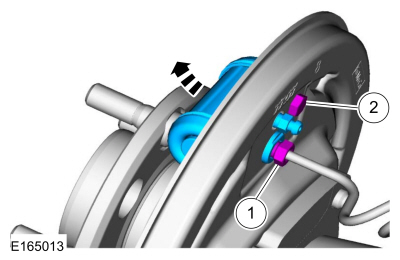Ford Fiesta: Climate Control System - General Information / Electronic Leak Detection. General Procedures
Special Tool(s) / General Equipment
| Electronic Leak Detector |
Inspection
-
NOTE: Use a Rotunda-approved Electronic Leak Detector for R-134a refrigerant SAE Certified to J2791.
NOTE: Good ventilation is necessary in the area where electronic A/C leak testing is to be carried out. If the surrounding air is contaminated with refrigerant gas, the leak detector indicates this gas all the time. Odors from other chemicals such as antifreeze, disc brake cleaner or other cleaning solvents can cause the same problem. Using a fan to ventilate the area to be tested before proceeding with the leak detection procedure is helpful in removing small traces of contamination from the air, but the fan should be turned off during actual testing.
NOTE: If the surrounding air is contaminated with refrigerant gas, the leak detector indicates this gas all the time. Odors from other chemicals such as antifreeze, disc brake cleaner or other cleaning solvents can cause the same problem.
NOTE: R-134a, if present, is heavier than air, and tends to move down from the source of the leak. It is possible that a leak may not be detected if the leak detector tip is held above the leaking fitting, line or component. Always be sure to thoroughly leak test below, above and around the fitting, line or component for the presence of R-134a.
Leak check the service ports. Remove caps and blow air over the service ports to remove trapped refrigerant before leak testing ports.
-
023‐22791 Robinair Infrared A/C Refrigerant Leak Detector w/Case
Use the General Equipment: Electronic Leak Detector
-
023‐22791 Robinair Infrared A/C Refrigerant Leak Detector w/Case
-
NOTE: The system pressure should be 413-551 kPa (60 - 80 psi) at 24° C (75.2° F) with the engine off and cool. The pressure reading may be higher if the engine is hot.
Leak test the refrigerant system. Follow the instructions included with the Electronic Leak Detector for handling and operation techniques.
 Condenser Core Leak Check. General Procedures
Condenser Core Leak Check. General Procedures
Special Tool(s) /
General Equipment
Air Conditioning Service Unit
Air Conditioning Adaptor Kit
Inspection
Recover the refrigerant...
 Evaporator Core Leak Check. General Procedures
Evaporator Core Leak Check. General Procedures
Special Tool(s) /
General Equipment
Air Conditioning Service Unit
Air Conditioning Adaptor Kit
Inspection
Recover the refrigerant...
Other information:
Ford Fiesta 2014 - 2019 Service Manual: Front Seat Backrest Cover. Removal and Installation
Special Tool(s) / General Equipment Flat Headed Screw Driver Hog Ring Plier Removal WARNING: Front seat backrest trim covers installed on seats equipped with seat side airbags cannot be repaired. A new trim cover must be installed...
Ford Fiesta 2014 - 2019 Service Manual: Information and Entertainment System - Component Location. Description and Operation
Item Description 1 6.5-inch (165 mm) FDIM 2 FCIM (with Sony®) 3 FCIM (without Sony®) 4 Front AM / FM /HD Radio® (if equipped) antenna coaxial cable and satellite radio/ GPS splitter/cable assembly 5 Microphone (located in the headliner) 6 RHF door midwoofer speaker ( LHF also shown) (without Sony®) ..
Categories
- Manuals Home
- Ford Fiesta Service Manual (2014 - 2019)
- Engine
- General Information
- Engine Cooling - 1.6L EcoBoost (132kW/180PS) – Sigma
- Engine System - General Information
- Manual Transmission - 6-Speed Manual Transmission – B6
Brake Backing Plate. Removal and Installation
Removal
NOTE: Removal steps in this procedure may contain installation details.
Remove the brake shoes.Refer to: Brake Shoes (206-02 Drum Brake, Removal and Installation).
Disconnect the brake tube fitting.
Torque: 159 lb.in (18 Nm) Remove the bolt and wheel cylinder.
Torque: 106 lb.in (12 Nm)
 Disconnect the brake shoe lever fitting and re
Disconnect the brake shoe lever fitting and re
